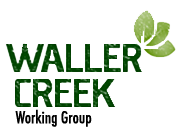Ultimately, the purpose of the Urban Ecosystems Research Stream is to study and understand the effects of restoration and urbanization on Waller Creek. Understanding how humans affect our surroundings on a small scale (the creek) can help us create a more comprehensive picture of how our species affects the environment as a whole. I could write about how this entails analyzing numerous amounts of complex data. I could write about how this entails bridging far reaching branches of science (such as chemistry, biology, ecology, etc.) in order to paint this full picture. However, there are plenty of my peers who may already have written about those things. Rather than the scientific, I would rather share the personal side of Urban Ecosystems, the side you don’t see in the data.
One of the hard truths of life is that sometimes you just have to get your hands dirty to get the job done. In Urban Ecosystems, we get our hands dirty by getting them wet. Because the primary objective of our research is to study the Creek, we have to get into the Creek. If we didn’t collect samples, then we wouldn’t be able to do anything period. This means that a large chunk of our time spent “researching” is really us waddling around in waders while trying our best to not slip and fall into the deep part of the water. Not exactly the pristine work environment with lab coats and microscopes that most people imagine when they think of research. Some days the water is freezing cold, and other days the sun is blistering hot. In Texas, it might as well be a coin flip. And the worst feeling of all? There’s nothing more awful than already being waist deep in the undrinkable creek water, and to only then realize that your “waterproof” wader has a hole in it. But by then it’s too late. Your whole leg is soaked, your day is ruined, and your disappointment is immeasurable. The only thing that puts some humor into the moment is the collective laughter from your friends who had the misfortune of wearing the very same leaky waders the week before. They say that shared trauma forges the strongest bonds, and I definitely see that in my research.
So far, my favorite part of Urban Ecosystems is the opportunity that I’ve had to meet some amazing people. Every single person there is memorable and friendly. Whether I’m talking to a mentor, a professor, or a fellow student, I always feel like I’m with a friend in Urban Ecosystems. Yes, of course we’re there to do research, but we’re also human beings. That means that any and every given chance, someone is cracking a joke or helping their neighbor. The great thing about these bonds is that they extend beyond Waller Creek or the research lab. I know that if I ever have a free moment and am looking for someone to spend it with, anyone in my research stream would be happy to join me (given that they’re not stuck in the lab or studying). When I think of Urban Ecosystems, I think of the smiling faces of all the friends I’ve made in my time there. When I recall getting my pants soaked in freezing cold water, I don’t look back with a bad taste in my mouth. Because of the wonderful people I was with, that was a moment filled with laughter and jokes rather than anger and cursing. With our days as freshmen coming to a close, none of us can stay in FRI with Urban Ecosystems much longer, but I surely hope that we stay in each other’s lives for as long as we can.
Nathan Vu
Team Energy
Urban Ecosystems Stream
| Leaky Waders | 5.33 MB |
